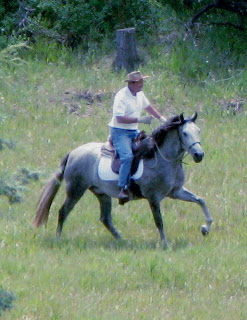Tuesday, May 24, 2011
Check out CowGirl Magazine!
Cowgirl Magazine has featured the Mangalarga Marchador as its first exotic horse breed. A small write-up, great photos and a few ads are in this Western art and fashion magazine that also loves horses!
Monday, May 2, 2011
The Marcha gait - more from the Clinic
My notes from the clinic:
Ø Perfect the 4 beat extended walk. (How many times are we told to practice a good walk in other disciplines?) It is ESSENTIAL for a good marcha as it is the take-off point and retreat point always.
Ø Practice in straight lines before teaching in circles, lateral work or ANY other discipline. Teach the horse to elongate his back, his stride, relax and stretch without speeding up.
Ø Always start on the good side for the stretches, but do both sides. Stretching from the good side will help the bad side to stretch easier.
Ø To move into gait: From the walk, apply more leg pressure and ask the horse to speed up without losing the smooth rhythm that was there in his walk. Collect the reins (have contact) with the horse’s mouth to ask him to collect his body in a good frame.
Ø Do NOT let your horse continue to gait if it is gaiting badly. Go back to the walk and start again. Ask for MORE SPEED from his legs while maintaining the collection. You are trying to build MUSCLE MEMORY. (This works really well! I tried it on my horses after the clinic)
Ø A marcha picada horse that paces is often still very smooth (I was surprised by this). You can tell because your hips will go side to side instead of forward and back. Try to put your leg on for more leg speed, but if that doesn’t work, return to the walk and start over.
Ø In marcha picada, you can help the horse learn the right rhythm by adding weight to the front feet (could be shoes) or the opposite in marcha batida.
Ø As you can see from the diagram on May 1's post, some horses will need help because of poorer conformation or breeding, but some horses need correction because someone interfered with their natural gait during training. The Marchador is a willing partner. If you ask it to change its natural footfall, it will learn to do what you want.
Ø You can use dressage to supple the horse and build muscle, but not too soon (remember straight lines). Once you can do the circles, you can move to a higher-level figure. The Marchador can do lateral work and the higher moves IN GAIT! (Another surprise for me!)
| Good breeding ensures a great gait naturally. This is Fidalgo do Summerwind, marcha de centro. |
| Dressage will help to supple the horse, stretch and build the muscles so it also helps get a smoother and better gait. |
Sunday, May 1, 2011
About the MARCHA gait - more from the clinic
| Elba Cruzalta (Bella) gaiting at liberty |
During the Brazilian inspection at age 3, gait is one of the most important dimensions of the test. Horse will be disqualified from permanent breeding registration if they are too lateral (show a pace) or too diagonal (show a trot). Gait counts for 100 points of the 200-point test.
In simple terms, when the greater proportion of time spent with the diagonal legs providing support, the marcha is BATIDA (ba chee da) When the greater proportion of time spent with the lateral legs providing support, the marcha is PICADA (pi ca dah). A few animals have equivalent time spent between diagonal and lateral supports. They are considered to be in the center, sometimes called marcha de CENTRO.
To visualize the spectrum, here is a diagram:
Pace--------picada-----centro-----batida --------Trot
(true lateral) (true diagonal)
Within the gaits, there is a grading system for how comfortable the gait is. L1 to L4 for picada; D1 to D4 for batida. On the diagram, it would look like this:
Pace --–L4-L3-L2-L1-—C—D1-D2-D3-D4----Trot
(true lateral) (true diagonal)
The clinic’s objective was to teach us all how to set the gait correctly (for an untrained horse) and also how to improve the gait. With training, the horse can move 2 steps like from D4 to D2 or L3 to L1.
 |
| Artemis do Summerwind showing triple leg support and the C shape of the front leg |
When the horses are bred close to the center, they may have the ability to perform both gaits – picada and batida. The naturalness of the gait is such that newborn foals will gait rather than walk or run.
Subscribe to:
Posts (Atom)
